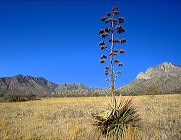
Photo by David Bly Agave, also known as “century plants,” are easily recognized with stout spear-like leaves that grow from the center of a rosette. This rosette of leaves concentrates rainwater near the plant’s base, thus creating a mechanism for self-irrigation. Despite their name, most agaves bloom within 15-30 years. The plant puts all its energy into the flowering stalk, then dies the following season. 
NPS Photo/K. Hooper Agave Planting and Seed Collection Days Stay tuned for the latest on how to help the park rehabilitate the agave population in the park's grassland habitat. Volunteer opportunities will be available to help park scientists collect agave seed and plant young agave pups. Contact the park for more information about volunteering: (520) 366-5515, or contact us via email. Check out this video that highlights our Resource Management Team's agave restoration project. Volunteer and students have helped plant thousands of new agaves in the park's grasslands to rehabilitate the landscape. The project has been ongoing for over two years, and we hope it will continue into the future. The requested video is no longer available.
|
Last updated: April 7, 2016
